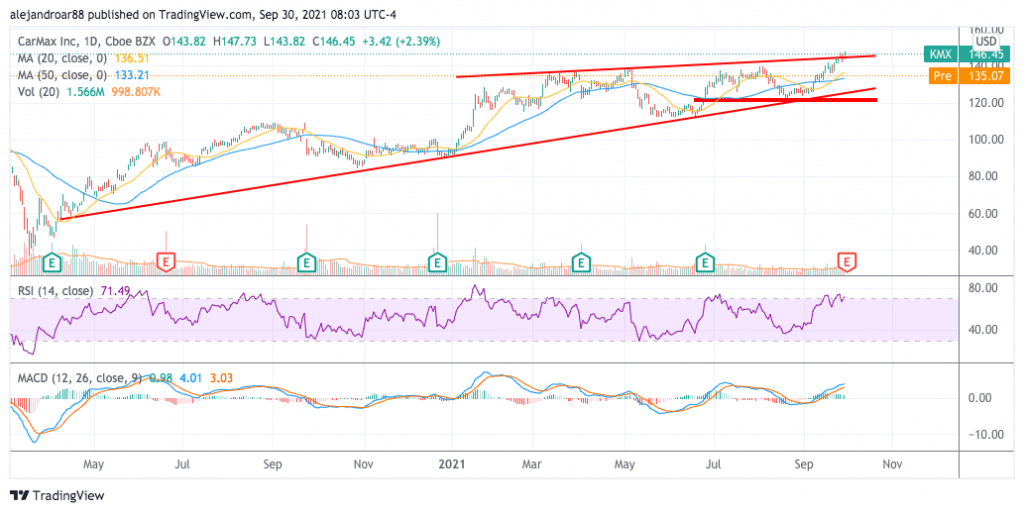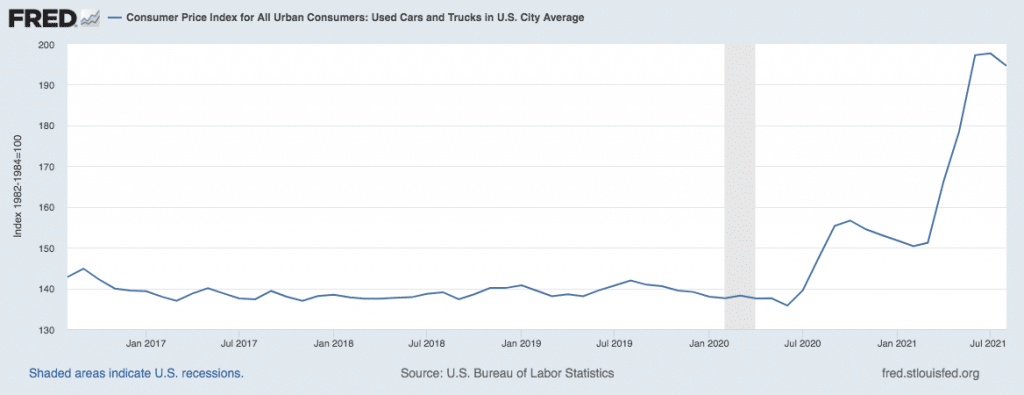CarMax Stock Down 8% Today – Time to Buy KMX Stock?
Please note that we are not authorised to provide any investment advice. The content on this page is for information purposes only.
The price of CarMax stock is dropping nearly 8% today in pre-market stock trading action following the release of the firm’s earnings report covering the second quarter of 2021 as earnings from the Virginia-based used car retailer missed analysts’ estimates for the period.
During the three months ended on 31 August, CarMax reported total revenues of $7.99 billion resulting in a 49% jump compared to the same period a year ago while exceeding analysts’ forecasts by one billion (16%) based on data compiled by Capital IQ.
Retail sales experienced a 39.1% advance during this second quarter and accounted for 76% of the company’s total sales at $6.1 billion compared to 82% they contributed during the second quarter of the 2020 fiscal year while wholesale sales more than doubled at $1.7 billion.
However, when measured in units, the number of used vehicles sold directly to customers (retail) only experienced a 6.7% advance while wholesale sales volumes in units advanced 41.4%.
Meanwhile, compared to the previous quarter, CarMax’s total revenues only advanced 3.8% while retail volumes (in units) retreated 14.4% and wholesale volumes advanced a meager 3.6%.
For market participants, this quarter-on-quarter deceleration in sales and volume growth may indicate that the tailwinds that the company had been experiencing lately amid a sharp increase in the price of used vehicles in the US could be starting to fade and that could affect the company’s results in the future.
What does the future hold for CarMax? In the following article, I’ll attempt to answer that question by assessing the firm’s price action and fundamentals.
67% of all retail investor accounts lose money when trading CFDs with this provider.
CarMax Stock – Technical Analysis

In a previous article I wrote in June, I set forth a $140 per share target for CarMax based on the positive catalyst provided by the firm’s earnings report back then. This report shattered analysts’ estimates and highlighted the positive momentum that used car retailers were experiencing.
That target was reached and even surpassed although the ride was a bit bumpy as the price action partially filled the bullish gap left behind back then at some point.
Now, this post-earnings decline may result in a change in the mid-term outlook for CarMax as certain fundamental factors may weigh on the company’s valuation.
If this pre-market decline spills over to the live session, a full-blown rejection of the trend line resistance shown in the chart would be in play and a large bearish price gap will probably emerge as well once the session starts.
The stock’s short-term moving averages, currently found at $136 (20-day SMA) and $133 (50-day SMA) could possibly act as support while a break below those levels may result in a drop towards the $130 level – the lower trend line support.
If the bullish gap is not filled, the outlook in the mid-term may continue to be bullish since even though volumes are slowing down, they remain fairly elevated compared to previous years.
CarMax Stock – Fundamental Analysis

Data from the St. Louis Federal Reserve Bank shows that the price index for used vehicles and trucks in the United States has started to decline since July this year. This would be the first time that the index experiences a monthly decline since January and may signal a potential short-term peak in the uptrend that used car prices have been experiencing in 2021.
CarMax has benefited tremendously from this jump in prices as reflected by its sales during the first semester of the 2022 fiscal year, as the company’s top-line results nearly doubled compared to the same period a year ago.
However, a higher contribution of wholesale sales to the mix has deteriorated the firm’s gross margins during the same period, moving from 12.9% back in the first semester of the 2021 fiscal year to 11.1% during the six months ended on 31 August. Meanwhile, this quarter’s figure was also 90 basis points lower than the gross margin reported a quarter ago.
As a result, the company’s bottom-line profitability has suffered and this decline was quite sharp on a quarter-on-quarter basis as diluted earnings per share declined 35% at $1.72.
Moving forward, analysts are expecting to see the firm’s earnings per share decline progressively for the remaining quarters of the 2022 fiscal year and, for the full year, they are expecting to see earnings per share landing at around $7.3 per share.
Perhaps more important, EPS growth is expected to stay flat for the next two years but these expectations might be too optimistic if used vehicle prices start to progressively decline in the following quarters.
As a result, even though CarMax is valued conservatively at a forward price-to-earnings multiple of 21, if the latest tailwind starts to fade, the firm’s future earnings growth will probably be negative and that will have a negative effect on its valuation. With that in mind, the outlook at the moment is bearish in the mid-term for KMX stock.






